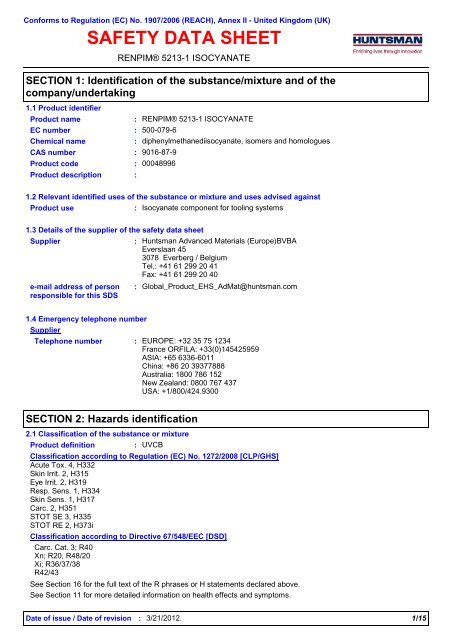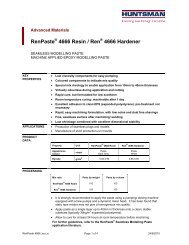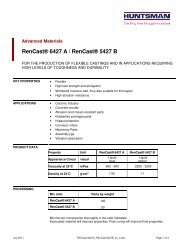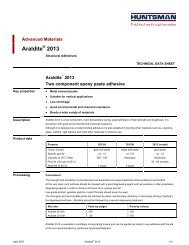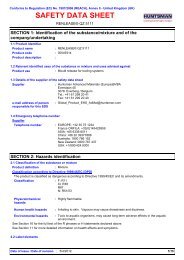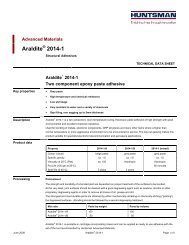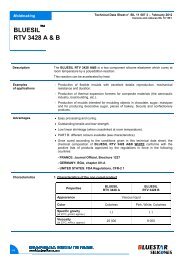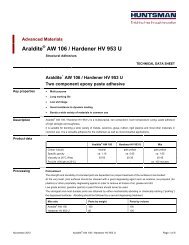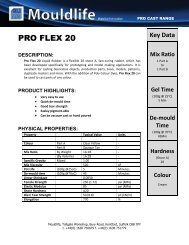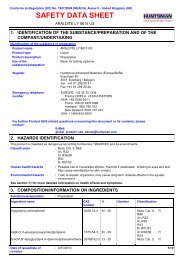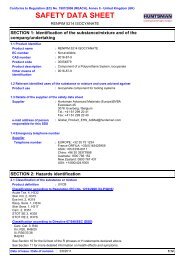View MSDS ISO - Mouldlife
View MSDS ISO - Mouldlife
View MSDS ISO - Mouldlife
You also want an ePaper? Increase the reach of your titles
YUMPU automatically turns print PDFs into web optimized ePapers that Google loves.
Conforms to Regulation (EC) No. 1907/2006 (REACH), Annex II - United Kingdom (UK)SAFETY DATA SHEETRENPIM® 5213-1 <strong>ISO</strong>CYANATESECTION 1: Identification of the substance/mixture and of thecompany/undertaking1.1 Product identifierProduct name: RENPIM® 5213-1 <strong>ISO</strong>CYANATEEC number : 500-079-6Chemical name: diphenylmethanediisocyanate, isomers and homologuesCAS number : 9016-87-9Product code : 00048996Product description :1.2 Relevant identified uses of the substance or mixture and uses advised againstProduct use : Isocyanate component for tooling systems1.3 Details of the supplier of the safety data sheetSuppliere-mail address of personresponsible for this SDS: Huntsman Advanced Materials (Europe)BVBAEverslaan 453078 Everberg / BelgiumTel.: +41 61 299 20 41Fax: +41 61 299 20 40: Global_Product_EHS_AdMat@huntsman.com1.4 Emergency telephone numberSupplierTelephone number : EUROPE: +32 35 75 1234France ORFILA: +33(0)145425959ASIA: +65 6336-6011China: +86 20 39377888Australia: 1800 786 152New Zealand: 0800 767 437USA: +1/800/424.9300SECTION 2: Hazards identification2.1 Classification of the substance or mixtureProduct definition : UVCBClassification according to Regulation (EC) No. 1272/2008 [CLP/GHS]Acute Tox. 4, H332Skin Irrit. 2, H315Eye Irrit. 2, H319Resp. Sens. 1, H334Skin Sens. 1, H317Carc. 2, H351STOT SE 3, H335STOT RE 2, H373iClassification according to Directive 67/548/EEC [DSD]Carc. Cat. 3; R40Xn; R20, R48/20Xi; R36/37/38R42/43See Section 16 for the full text of the R phrases or H statements declared above.See Section 11 for more detailed information on health effects and symptoms.Date of issue / Date of revision : 3/21/2012.1/15
Conforms to Regulation (EC) No. 1907/2006 (REACH), Annex II - United Kingdom (UK)RENPIM 5213-1 <strong>ISO</strong>CYANATEDate of printing : 21 March 2012<strong>MSDS</strong> no.: 00048996Date of issue : 21 March 2012Version : 22/15SECTION 2: Hazards identification2.2 Label elementsHazard pictograms :Signal word :Hazard statements :DangerHarmful if inhaled.Causes skin irritation.Causes serious eye irritation.May cause allergy or asthma symptoms or breathing difficulties if inhaled.May cause an allergic skin reaction.Suspected of causing cancer.May cause respiratory irritation.May cause damage to organs through prolonged or repeated exposure if inhaled.Precautionary statementsGeneral: Not applicable.Prevention : Obtain special instructions before use. Wear protective gloves: >8 hours(breakthrough time): Ethyl Vinyl Alcohol Laminate (EVAL), butyl rubber. Wear eye orface protection. Do not breathe vapour or spray.Response :Storage :Disposal :Supplemental labelelementsSupplemental labelelementsIF INHALED: Remove victim to fresh air and keep at rest in a position comfortablefor breathing. If experiencing respiratory symptoms: Call a PO<strong>ISO</strong>N CENTER orphysician.Store locked up.Not applicable.Special packaging requirementsContainers to be fittedwith child-resistantfastenings: Not applicable.Tactile warning of danger: Not applicable.: Contains isocyanates - See information supplied by the manufacturers. Thisinformation is supplied in the current Safety Data Sheet.:Not applicable.2.3 Other hazardsSubstance meets thecriteria for PBT accordingto Regulation (EC) No.1907/2006, Annex XIIISubstance meets thecriteria for vPvB accordingto Regulation (EC) No.1907/2006, Annex XIIIOther hazards which donot result in classification: PBT: No.P: No. B: No. T: No.: vPvB: No.vP: No. vB: No.:Not available.Date of issue / Date of revision : 3/21/2012.2/15
Conforms to Regulation (EC) No. 1907/2006 (REACH), Annex II - United Kingdom (UK)RENPIM 5213-1 <strong>ISO</strong>CYANATEDate of printing : 21 March 2012<strong>MSDS</strong> no.: 00048996Date of issue : 21 March 2012Version : 2SECTION 2: Hazards identification3/15SECTION 3: Composition/information on ingredientsSubstance/mixtureProduct/ingredientnamediphenylmethanediisocyanate,isomers andhomologues:UVCBIdentifiersCAS: 9016-87-9EC: 500-079-6% 67/548/EEC Regulation (EC) No. Type1272/2008 [CLP]60-100 Carc. Cat. 3; R40Xn; R20, R48/20Xi; R36/37/38R42/43See section 16 forthe full text of the R-phrases declaredaboveClassificationAcute Tox. 4, H332Skin Irrit. 2, H315Eye Irrit. 2, H319Resp. Sens. 1, H334Skin Sens. 1, H317Carc. 2, H351STOT SE 3, H335STOT RE 2, H373iSee Section 16 for thefull text of the Hstatements declaredabove.[A]There are no additional ingredients present which, within the current knowledge of the supplier, are classified andcontribute to the classification of the substance and hence require reporting in this section.Type[*] Substance[A] Constituent[B] Impurity[C] Stabilising additiveOccupational exposure limits, if available, are listed in Section 8.SECTION 4: First aid measures4.1 Description of first aid measuresEye contact: Immediately flush eyes with plenty of water, occasionally lifting the upper and lowereyelids. Check for and remove any contact lenses. Continue to rinse for at least 10minutes. Get medical attention.Inhalation:Remove victim to fresh air and keep at rest in a position comfortable for breathing. Ifit is suspected that fumes are still present, the rescuer should wear an appropriatemask or self-contained breathing apparatus. If not breathing, if breathing is irregularor if respiratory arrest occurs, provide artificial respiration or oxygen by trainedpersonnel. It may be dangerous to the person providing aid to give mouth-to-mouthresuscitation. Get medical attention. If necessary, call a poison center or physician.If unconscious, place in recovery position and get medical attention immediately.Maintain an open airway. Loosen tight clothing such as a collar, tie, belt orwaistband. In the event of any complaints or symptoms, avoid further exposure.Date of issue / Date of revision : 3/21/2012.3/15
Conforms to Regulation (EC) No. 1907/2006 (REACH), Annex II - United Kingdom (UK)RENPIM 5213-1 <strong>ISO</strong>CYANATEDate of printing : 21 March 2012<strong>MSDS</strong> no.: 00048996Date of issue : 21 March 2012Version : 24/15SECTION 4: First aid measuresSkin contactIngestion::Wash with plenty of soap and water. Remove contaminated clothing and shoes.Wash contaminated clothing thoroughly with water before removing it, or weargloves. Continue to rinse for at least 10 minutes. Get medical attention. In theevent of any complaints or symptoms, avoid further exposure. Wash clothing beforereuse. Clean shoes thoroughly before reuse.Wash out mouth with water. Remove dentures if any. Remove victim to fresh airand keep at rest in a position comfortable for breathing. If material has beenswallowed and the exposed person is conscious, give small quantities of water todrink. Stop if the exposed person feels sick as vomiting may be dangerous. Do notinduce vomiting unless directed to do so by medical personnel. If vomiting occurs,the head should be kept low so that vomit does not enter the lungs. Get medicalattention. Never give anything by mouth to an unconscious person. If unconscious,place in recovery position and get medical attention immediately. Maintain an openairway. Loosen tight clothing such as a collar, tie, belt or waistband.Protection of first-aiders: No action shall be taken involving any personal risk or without suitable training. If it issuspected that fumes are still present, the rescuer should wear an appropriate maskor self-contained breathing apparatus. It may be dangerous to the person providingaid to give mouth-to-mouth resuscitation. Wash contaminated clothing thoroughlywith water before removing it, or wear gloves.4.2 Most important symptoms and effects, both acute and delayedPotential acute health effectsEye contactInhalationSkin contactIngestion:Causes serious eye irritation.: Harmful if inhaled. May cause respiratory irritation. May cause allergy or asthmasymptoms or breathing difficulties if inhaled.: Causes skin irritation. May cause an allergic skin reaction.: Irritating to mouth, throat and stomach.Over-exposure signs/symptomsEye contact: Adverse symptoms may include the following:pain or irritationwateringrednessInhalationSkin contactIngestion:Adverse symptoms may include the following:respiratory tract irritationcoughingwheezing and breathing difficultiesasthma: Adverse symptoms may include the following:irritationredness: No specific data.4.3 Indication of any immediate medical attention and special treatment neededNotes to physician : Treat symptomatically. Contact poison treatment specialist immediately if largequantities have been ingested or inhaled.Specific treatments: Symptomatic treatment and supportive therapy as indicated. Following severeexposure the patient should be kept under medical review for at least 48 hours.Date of issue / Date of revision : 3/21/2012.4/15
Conforms to Regulation (EC) No. 1907/2006 (REACH), Annex II - United Kingdom (UK)RENPIM 5213-1 <strong>ISO</strong>CYANATEDate of printing : 21 March 2012<strong>MSDS</strong> no.: 00048996Date of issue : 21 March 2012Version : 25/15SECTION 5: Firefighting measures5.1 Extinguishing mediaSuitable extinguishingmediaUnsuitable extinguishingmedia::Use an extinguishing agent suitable for the surrounding fire.None known.5.2 Special hazards arising from the substance or mixtureHazards from thesubstance or mixture: In a fire or if heated, a pressure increase will occur and the container may burst.Hazardous thermaldecomposition products:No specific data.5.3 Advice for firefightersSpecial precautions forfire-fightersSpecial protectiveequipment for fire-fighters::Promptly isolate the scene by removing all persons from the vicinity of the incident ifthere is a fire. No action shall be taken involving any personal risk or without suitabletraining.Fire-fighters should wear appropriate protective equipment and self-containedbreathing apparatus (SCBA) with a full face-piece operated in positive pressuremode. Clothing for fire-fighters (including helmets, protective boots and gloves)conforming to European standard EN 469 will provide a basic level of protection forchemical incidents.SECTION 6: Accidental release measures6.1 Personal precautions, protective equipment and emergency proceduresFor non-emergencypersonnelFor emergency responders ::No action shall be taken involving any personal risk or without suitable training.Evacuate surrounding areas. Keep unnecessary and unprotected personnel fromentering. Do not touch or walk through spilt material. Avoid breathing vapour ormist. Provide adequate ventilation. Wear appropriate respirator when ventilation isinadequate. Put on appropriate personal protective equipment.If specialised clothing is required to deal with the spillage, take note of anyinformation in Section 8 on suitable and unsuitable materials. See also theinformation in "For non-emergency personnel".6.2 Environmentalprecautions:Avoid dispersal of spilt material and runoff and contact with soil, waterways, drainsand sewers. Inform the relevant authorities if the product has caused environmentalpollution (sewers, waterways, soil or air).6.3 Methods and materials for containment and cleaning upSmall spill : Stop leak if without risk. Move containers from spill area. Dilute with water and mopup if water-soluble. Alternatively, or if water-insoluble, absorb with an inert drymaterial and place in an appropriate waste disposal container. Dispose of via alicensed waste disposal contractor.Large spill :Stop leak if without risk. Move containers from spill area. Approach the releasefrom upwind. Prevent entry into sewers, water courses, basements or confinedareas. Wash spillages into an effluent treatment plant or proceed as follows.Contain and collect spillage with non-combustible, absorbent material e.g. sand,earth, vermiculite or diatomaceous earth and place in container for disposalaccording to local regulations (see section 13). Dispose of via a licensed wastedisposal contractor. Contaminated absorbent material may pose the same hazardas the spilt product. Note: see section 1 for emergency contact information andsection 13 for waste disposal.Date of issue / Date of revision : 3/21/2012.5/15
Conforms to Regulation (EC) No. 1907/2006 (REACH), Annex II - United Kingdom (UK)RENPIM 5213-1 <strong>ISO</strong>CYANATEDate of printing : 21 March 2012<strong>MSDS</strong> no.: 00048996Date of issue : 21 March 2012Version : 26/15SECTION 6: Accidental release measures6.4 Reference to othersectionsSECTION 7: Handling and storage:See Section 1 for emergency contact information.See Section 8 for information on appropriate personal protective equipment.See Section 13 for additional waste treatment information.The information in this section contains generic advice and guidance. The list of Identified Uses in Section 1 should beconsulted for any available use-specific information provided in the Exposure Scenario(s).7.1 Precautions for safe handlingProtective measures : Put on appropriate personal protective equipment (see Section 8). Persons with ahistory of skin sensitisation problems or asthma, allergies or chronic or recurrentrespiratory disease should not be employed in any process in which this product isused. Avoid exposure - obtain special instructions before use. Do not handle untilall safety precautions have been read and understood. Do not get in eyes or on skinor clothing. Do not breathe vapour or mist. Do not ingest. Use only with adequateventilation. Wear appropriate respirator when ventilation is inadequate. Keep in theoriginal container or an approved alternative made from a compatible material, kepttightly closed when not in use. Empty containers retain product residue and can behazardous. Do not reuse container.Advice on generaloccupational hygiene:Eating, drinking and smoking should be prohibited in areas where this material ishandled, stored and processed. Workers should wash hands and face beforeeating, drinking and smoking. Remove contaminated clothing and protectiveequipment before entering eating areas. See also Section 8 for additionalinformation on hygiene measures.7.2 Conditions for safestorage, including anyincompatibilitiesStorage hazard classHuntsman AdvancedMaterials:Store between the following temperatures: 2 to 40°C (35.6 to 104°F). Store inaccordance with local regulations. Store in original container protected from directsunlight in a dry, cool and well-ventilated area, away from incompatible materials(see section 10) and food and drink. Store locked up. Keep container tightly closedand sealed until ready for use. Containers that have been opened must be carefullyresealed and kept upright to prevent leakage. Do not store in unlabelled containers.Use appropriate containment to avoid environmental contamination.: Storage class 12, Liquids, not dangerous7.3 Specific end use(s)Recommendations :Industrial sector specific :solutionsNot available.Not available.SECTION 8: Exposure controls/personal protectionThe information in this section contains generic advice and guidance. The list of Identified Uses in Section 1 should beconsulted for any available use-specific information provided in the Exposure Scenario(s).8.1 Control parametersOccupational exposure limitsDate of issue / Date of revision : 3/21/2012.6/15
Conforms to Regulation (EC) No. 1907/2006 (REACH), Annex II - United Kingdom (UK)RENPIM 5213-1 <strong>ISO</strong>CYANATEDate of printing : 21 March 2012<strong>MSDS</strong> no.: 00048996Date of issue : 21 March 2012Version : 27/15SECTION 8: Exposure controls/personal protectionProduct/ingredient namediphenylmethanediisocyanate, isomers andhomologuesExposure limit valuesEH40/2005 WELs (United Kingdom (UK), 8/2007). Skinsensitiser. Notes: as NCOSTEL: 0.07 mg/m³, (as NCO) 15 minute(s).TWA: 0.02 mg/m³, (as NCO) 8 hour(s).Recommended monitoringproceduresDerived effect levelsNo DELs available.:If this product contains ingredients with exposure limits, personal, workplaceatmosphere or biological monitoring may be required to determine the effectivenessof the ventilation or other control measures and/or the necessity to use respiratoryprotective equipment. Reference should be made to European Standard EN 689 formethods for the assessment of exposure by inhalation to chemical agents andnational guidance documents for methods for the determination of hazardoussubstances.Predicted effect concentrationsNo PECs available.8.2 Exposure controlsAppropriate engineeringcontrolsIndividual protection measuresHygiene measures :Eye/face protectionSkin protectionHand protectionMaterial of gloves forlong term application(BTT>480min):Material of gloves forshort term/splashapplication(10min
Conforms to Regulation (EC) No. 1907/2006 (REACH), Annex II - United Kingdom (UK)RENPIM 5213-1 <strong>ISO</strong>CYANATEDate of printing : 21 March 2012<strong>MSDS</strong> no.: 00048996Date of issue : 21 March 2012Version : 28/15SECTION 8: Exposure controls/personal protectionOther skin protectionRespiratory protection :Environmental exposurecontrolsPhysical stateColourOdourpHMelting point/freezing pointInitial boiling point and boilingrange:Appropriate footwear and any additional skin protection measures should beselected based on the task being performed and the risks involved and should beapproved by a specialist before handling this product.In case of inadequate ventilation wear respiratory protection. Respirator selectionmust be based on known or anticipated exposure levels, the hazards of the productand the safe working limits of the selected respirator.: Emissions from ventilation or work process equipment should be checked to ensurethey comply with the requirements of environmental protection legislation. In somecases, fume scrubbers, filters or engineering modifications to the processequipment will be necessary to reduce emissions to acceptable levels.SECTION 9: Physical and chemical properties9.1 Information on basic physical and chemical propertiesAppearanceOdour threshold:::::::Liquid.Brown.mustyNot available.Not available.300°CFlash pointEvaporation rateFlammability (solid, gas)Burning timeBurning rateUpper/lower flammability orexplosive limits::Closed cup: >250°C [DIN 51758 EN 22719 (Pensky-Martens Closed Cup)]Open cup: 230°CNot available.: Not available.:::Not applicable.Not applicable.Not available.Vapour pressureVapour densityRelative densitySolubility(ies)Water solubility ::::600°CDecomposition temperature : >300°CViscosity: Dynamic: 190 to 210 mPa·sExplosive properties: Not available.Oxidising properties : None.25 deg C9.2 Other informationDensity: 1.24 g/cm 3 [20°C (68°F)]Date of issue / Date of revision : 3/21/2012.8/15
Conforms to Regulation (EC) No. 1907/2006 (REACH), Annex II - United Kingdom (UK)RENPIM 5213-1 <strong>ISO</strong>CYANATE9/15Date of printing : 21 March 2012<strong>MSDS</strong> no.: 00048996Date of issue : 21 March 2012Version : 2SECTION 10: Stability and reactivity10.1 Reactivity : No specific test data related to reactivity available for this product or its ingredients.10.2 Chemical stability :The product is stable.10.3 Possibility ofhazardous reactions: Under normal conditions of storage and use, hazardous reactions will not occur.Hydrolysis in contact with water10.4 Conditions to avoid : No specific data.10.5 Incompatible materials :strong acids, strong bases, Water10.6 Hazardousdecomposition productsSECTION 11: Toxicological information11.1 Information on toxicological effectsAcute toxicitydiphenylmethanediisocyanate,isomers and homologues:Under normal conditions of storage and use, hazardous decomposition productsshould not be produced.Decomposition products may include the following materials:Carbon oxides, Nitrogenoxides, Burning produces obnoxious and toxic fumes.Product/ingredient name Endpoint Species Result ExposureIrritation/CorrosionConclusion/SummarySkin :Eyes :Respiratory :SensitiserCarcinogenicityLD50 Oral Rat >10000 mg/kg -Product/ingredient name Test Route ofexposurediphenylmethanediisocyanate,isomers and homologuesConclusion/SummaryMutagenicitydiphenylmethanediisocyanate,isomers and homologuesNo additional information.No additional information.No additional information.- skin Guinea pig Sensitising: No additional information.Product/ingredient name Test ResultOECD 474Negative- EquivocalSpeciesResultProduct/ingredientnamediphenylmethanediisocyanate,isomers andhomologuesTest Species Exposure ResultOECD 453 Combined ChronicToxicity/CarcinogenicityStudiesRat 2 years; 5days perweekEU Rat 2 years; 5days perweekRoute ofexposureNegative Inhalation -Negative Inhalation -TargetorgansDate of issue / Date of revision : 3/21/2012.9/15
Conforms to Regulation (EC) No. 1907/2006 (REACH), Annex II - United Kingdom (UK)RENPIM 5213-1 <strong>ISO</strong>CYANATEDate of printing : 21 March 2012<strong>MSDS</strong> no.: 00048996Date of issue : 21 March 2012Version : 210/15SECTION 11: Toxicological informationReproductive toxicityProduct/ingredient name Test Species Result/Result type Targetorgansdiphenylmethanediisocyanate,isomers and homologuesTeratogenicityOECD 414 Prenatal DevelopmentalToxicity StudyRat Inhalation: NOAEL -Product/ingredient name Test Species Result/Result typediphenylmethanediisocyanate,isomers and homologuesOECD 414 Prenatal DevelopmentalToxicity StudyRat - Male,Female4 mg/m3 NOAELSpecific target organ toxicity (single exposure)Specific target organ toxicity (repeated exposure)Aspiration hazardNot available.Product/ingredient nameProduct/ingredient nameCategoryCategoryRoute ofexposureTarget organsdiphenylmethanediisocyanate, isomers and homologues Category 3 Not determined Respiratory tractirritationRoute ofexposureTarget organsdiphenylmethanediisocyanate, isomers and homologues Category 2 Inhalation Not determinedInformation on the likelyroutes of exposure:Not available.Potential acute health effectsInhalation: Harmful if inhaled. May cause respiratory irritation. May cause allergy or asthmasymptoms or breathing difficulties if inhaled.Ingestion: Irritating to mouth, throat and stomach.Skin contact: Causes skin irritation. May cause an allergic skin reaction.Eye contact: Causes serious eye irritation.Symptoms related to the physical, chemical and toxicological characteristicsInhalation: Adverse symptoms may include the following:respiratory tract irritationcoughingwheezing and breathing difficultiesasthmaIngestionSkin contactEye contact::No specific data.Adverse symptoms may include the following:irritationredness: Adverse symptoms may include the following:pain or irritationwateringrednessDelayed and immediate effects and also chronic effects from short and long term exposureShort term exposurePotential immediateeffects:Not available.Potential delayed effects :Long term exposureNot available.Date of issue / Date of revision : 3/21/2012.10/15
Conforms to Regulation (EC) No. 1907/2006 (REACH), Annex II - United Kingdom (UK)RENPIM 5213-1 <strong>ISO</strong>CYANATEDate of printing :Date of issue :21 March 201221 March 2012SECTION 11: Toxicological informationPotential immediateeffectsPotential delayed effects : Not available.Potential chronic health effectsdiphenylmethanediisocyanate,isomers and homologues:Not available.OECD 453 Combined ChronicToxicity/CarcinogenicityStudiesOECD 412 Repeated DoseInhalation Toxicity: 28-day or14-day Study<strong>MSDS</strong> no.Version :Product/ingredient name Test Result type ResultNOECLOECDusts andmistsDusts andmists: 0004899620.2 mg/m3 -1.1 mg/m3 -Target organs11/15Conclusion/Summary: Not available.General :Carcinogenicity :May cause damage to organs through prolonged or repeated exposure if inhaled.Once sensitized, a severe allergic reaction may occur when subsequently exposedto very low levels.Suspected of causing cancer. Risk of cancer depends on duration and level ofexposure.IARC : diphenylmethanediisocyanate, isomers and homologues 3Mutagenicity : No known significant effects or critical hazards.Teratogenicity : No known significant effects or critical hazards.Developmental effects : No known significant effects or critical hazards.Fertility effects: No known significant effects or critical hazards.Other information : Not available.SECTION 12: Ecological information12.1 ToxicityProduct/ingredient name TestEndpoint Exposure Species Resultdiphenylmethanediisocyanate,isomers and homologues- Acute EC50 24 hours Daphnia >1000 mg/L- Acute LC0 96 hours Fish >1000 mg/L12.2 Persistence and degradabilityProduct/ingredient name Aquatic half-life Photolysis Biodegradabilitydiphenylmethanediisocyanate,isomers and homologuesFresh water 0.8 days - -12.3 Bioaccumulative potentialProduct/ingredient namediphenylmethanediisocyanate,isomers and homologuesLogPow BCF Potential- 200 high12.4 Mobility in soilSoil/water partitioncoefficient (KOC)Mobility::Not available.Not available.12.5 Results of PBT and vPvB assessmentDate of issue / Date of revision : 3/21/2012.11/15
Conforms to Regulation (EC) No. 1907/2006 (REACH), Annex II - United Kingdom (UK)RENPIM 5213-1 <strong>ISO</strong>CYANATEDate of printing : 21 March 2012<strong>MSDS</strong> no.: 00048996Date of issue : 21 March 2012Version : 212/15SECTION 12: Ecological informationPBTvPvB: PBT: No.P: No. B: No. T: No.: vPvB: No.vP: No. vB: No.12.6 Other adverse effects : No known significant effects or critical hazards.12.7 Other ecological informationSECTION 13: Disposal considerationsThe information in this section contains generic advice and guidance. The list of Identified Uses in Section 1 should beconsulted for any available use-specific information provided in the Exposure Scenario(s).13.1 Waste treatment methodsProductMethods of disposalHazardous waste :Yes.European waste catalogue (EWC)Waste code:The generation of waste should be avoided or minimised wherever possible.Significant quantities of waste product residues should not be disposed of via thefoul sewer but processed in a suitable effluent treatment plant. Dispose of surplusand non-recyclable products via a licensed waste disposal contractor. Disposal ofthis product, solutions and any by-products should at all times comply with therequirements of environmental protection and waste disposal legislation and anyregional local authority requirements.07 02 08* other still bottoms and reaction residuesWaste designationPackagingMethods of disposal :Special precautions :The generation of waste should be avoided or minimised wherever possible. Wastepackaging should be recycled. Incineration or landfill should only be consideredwhen recycling is not feasible.This material and its container must be disposed of in a safe way. Care should betaken when handling emptied containers that have not been cleaned or rinsed out.Empty containers or liners may retain some product residues. Avoid dispersal ofspilt material and runoff and contact with soil, waterways, drains and sewers.SECTION 14: Transport information14.1 UN number 14.2 UN proper shipping nameADR/RIDIMDGIATANot regulated.Not regulated.Not regulated.---14.3 Transporthazard class(es)14.4 Packinggroup14.5Environmentalhazards14.6 Specialprecautions foruserAdditionalinformationADR/RID- -No.Not available.-IMDG- -No.Not available.-IATA- -No.Not available.-Date of issue / Date of revision : 3/21/2012.12/15
Conforms to Regulation (EC) No. 1907/2006 (REACH), Annex II - United Kingdom (UK)RENPIM 5213-1 <strong>ISO</strong>CYANATEDate of printing : 21 March 2012<strong>MSDS</strong> no.: 00048996Date of issue : 21 March 2012Version : 213/15SECTION 14: Transport information14.7 Transport in bulkaccording to Annex II ofMARPOL 73/78 and the IBCCode: Not applicable.SECTION 15: Regulatory information15.1 Safety, health and environmental regulations/legislation specific for the substance or mixtureEU Regulation (EC) No. 1907/2006 (REACH)Annex XIV - List of substances subject to authorisationSubstances of very high concernNone of the components are listed.Annex XVII - Restrictionson the manufacture,placing on the market anduse of certain dangeroussubstances, mixtures andarticles: Not applicable.Other EU regulationsEurope inventoryBlack List ChemicalsPriority List ChemicalsIntegrated pollutionprevention and controllist (IPPC) - AirIntegrated pollutionprevention and controllist (IPPC) - Water: This material is listed or exempted.: Not listed: Not listed: Not listed: Not listedProduct/ingredient namediphenylmethanediisocyanate,isomers and homologuesCarcinogeniceffectsMutagenic effectsDevelopmentaleffectsCarc. 2, H351 - - -Fertility effectsNational regulationsReferencesInternational regulationsChemical WeaponsConvention List Schedule IChemicalsChemical WeaponsConvention List Schedule IIChemicalsChemical WeaponsConvention List Schedule IIIChemicals: The provision of Safety Data Sheets comes under Regulation 6 of CHIP (CHIP is therecognised abbreviation for the Chemicals Hazard Information and PackagingRegulations). This is an addition to the Health and Safety at Work Act 1974.: Not listed: Not listed: Not listed15.2 Chemical SafetyAssessment:Not available.Date of issue / Date of revision : 3/21/2012.13/15
Conforms to Regulation (EC) No. 1907/2006 (REACH), Annex II - United Kingdom (UK)RENPIM 5213-1 <strong>ISO</strong>CYANATEDate of printing :Date of issue :21 March 201221 March 2012SECTION 16: Other information<strong>MSDS</strong> no.Indicates information that has changed from previously issued version.Abbreviations andacronymsFull text of abbreviated Hstatements:Version :: 00048996: ATE = Acute Toxicity EstimateCLP = Classification, Labelling and Packaging Regulation [Regulation (EC) No.1272/2008]DNEL = Derived No Effect LevelEUH statement = CLP-specific Hazard statementPNEC = Predicted No Effect ConcentrationRRN = REACH Registration NumberProcedure used to derive the classification according to Regulation (EC) No. 1272/2008 [CLP/GHS]Acute Tox. 4, H332Skin Irrit. 2, H315Eye Irrit. 2, H319Resp. Sens. 1, H334Skin Sens. 1, H317Carc. 2, H351STOT SE 3, H335STOT RE 2, H373iClassificationH315H317H319H332H334H335H351H373iExpert judgmentExpert judgmentExpert judgmentExpert judgmentExpert judgmentExpert judgmentExpert judgmentExpert judgmentJustification214/15Causes skin irritation.May cause an allergic skin reaction.Causes serious eye irritation.Harmful if inhaled.May cause allergy or asthma symptoms or breathing difficulties if inhaled.May cause respiratory irritation.Suspected of causing cancer.May cause damage to organs through prolonged or repeated exposure ifinhaled.Full text of classifications[CLP/GHS]Full text of abbreviated Rphrases::Acute Tox. 4, H332 ACUTE TOXICITY: INHALATION - Category 4Carc. 2, H351 CARCINOGENICITY - Category 2Eye Irrit. 2, H319 SERIOUS EYE DAMAGE/ EYE IRRITATION - Category 2Resp. Sens. 1, H334 RESPIRATORY SENSITIZATION - Category 1Skin Irrit. 2, H315 SKIN CORROSION/IRRITATION - Category 2Skin Sens. 1, H317 SKIN SENSITIZATION - Category 1STOT RE 2, H373i SPECIFIC TARGET ORGAN TOXICITY (REPEATEDEXPOSURE): INHALATION - Category 2STOT SE 3, H335 SPECIFIC TARGET ORGAN TOXICITY (SINGLEEXPOSURE) [Respiratory tract irritation] - Category 3R40- Limited evidence of a carcinogenic effect.R20- Harmful by inhalation.R48/20- Harmful: danger of serious damage to health by prolonged exposurethrough inhalation.R36/37/38- Irritating to eyes, respiratory system and skin.R42/43- May cause sensitisation by inhalation and skin contact.Full text of classifications[DSD/DPD]<strong>MSDS</strong> no. : 00048996Date of printingDate of issue/ Date ofrevisionDate of previous issue:::3/21/2012.3/21/2012.1/12/2011.Version: 2Notice to reader:Carc. Cat. 3 - Carcinogen category 3Xn - HarmfulXi - IrritantDate of issue / Date of revision : 3/21/2012.14/15
Conforms to Regulation (EC) No. 1907/2006 (REACH), Annex II - United Kingdom (UK)RENPIM 5213-1 <strong>ISO</strong>CYANATEDate of printing : 21 March 2012<strong>MSDS</strong> no.: 00048996Date of issue : 21 March 2012Version : 215/15SECTION 16: Other informationWhile the information and recommendations in this publication are to the best of our knowledge, informationand belief accurate at the date of publication, NOTHING HEREIN IS TO BE CONSTRUED AS A WARRANTY,EXPRESS OR OTHERWISE.IN ALL CASES, IT IS THE RESPONSIBILITY OF THE USER TO DETERMINE THE APPLICABILITY OF SUCHINFORMATION AND RECOMMENDATIONS AND THE SUITABILITY OF ANY PRODUCT FOR ITS OWNPARTICULAR PURPOSE.THE PRODUCT MAY PRESENT HAZARDS AND SHOULD BE USED WITH CAUTION. WHILE CERTAIN HAZARDSARE DESCRIBED IN THIS PUBLICATION, NO GUARANTEE IS MADE THAT THESE ARE THE ONLY HAZARDSTHAT EXIST.Hazards, toxicity and behaviour of the products may differ when used with other materials and are dependentupon the manufacturing circumstances or other processes. Such hazards, toxicity and behaviour should bedetermined by the user and made known to handlers, processors and end users.RENPIM® is a registered trademark of Huntsman Corporation or an affiliate thereof in one or more countries,but not all countries.NO PERSON OR ORGANIZATION EXCEPT A DULY AUTHORIZED HUNTSMAN EMPLOYEE IS AUTHORIZED TOPROVIDE OR MAKE AVAILABLE DATA SHEETS FOR HUNTSMAN PRODUCTS. DATA SHEETS FROMUNAUTHORIZED SOURCES MAY CONTAIN INFORMATION THAT IS NO LONGER CURRENT OR ACCURATE.NO PART OF THIS DATA SHEET MAY BE REPRODUCED OR TRANSMITTED IN ANY FORM, OR BY ANYMEANS, WITHOUT PERMISSION IN WRITING FROM HUNTSMAN. ALL REQUESTS FOR PERMISSION TOREPRODUCE MATERIAL FROM THIS DATA SHEET SHOULD BE DIRECTED TO HUNTSMAN, MANAGER,PRODUCT SAFETY AT THE ABOVE ADDRESS.Date of issue / Date of revision : 3/21/2012.15/15


